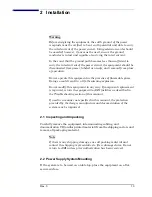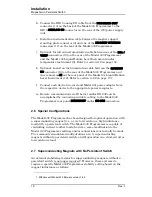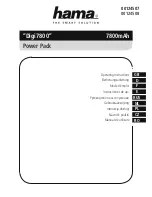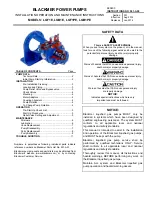
22
Rev.
3
Installation
Power-Up Procedure
12. The system should ramp to 10 A in approximately 10 seconds.
Verify this is the case (if a PSwitch is installed and in the cooled
state, ramp time to 10 A should be slightly less than 2 seconds).
Note
With an energy absorber unit is connected, the Model 430
Programmer may take significantly longer to ramp the current to 10
A. The Model 430 must first develop a supply output voltage to
overcome the forward voltage drop of a connected energy absorber.
During actual magnet operation, the presence of an energy absorber
will not significantly delay the ramping operation since the Model
430 control gain is increased by orders of magnitude when an
inductive load is connected (unless stability setting is 100%).
13. When the target current is achieved, the
FIELD AT TARGET
LED
will be illuminated. The display should show “
+10.00 A -
”
indicating that the Model 430 Programmer is in the holding mode
at the target current value (+10.00 A).
Note
There may be a discrepancy between the current shown on the power
supply display
1
and the current displayed on the Model 430
Programmer. The current measurement system incorporated in the
Model 430 is more accurate than the power supply shunt.
14. Verify that the output current display of the power supply indicates
that it is supplying 10 A to the load (which is only the cabling in
this case).
15. Set the target current to the master current limit value. Refer to
section 3.10.2.4 on page 56 to determine the master current limit
value. After the new target current value is entered, the Model 430
Programmer should ramp automatically to the new setting.
16. When the new target current value is reached, the power supply
current display (if provided) should also indicate the new value.
17. Press the
RAMP TO ZERO
key to ramp the system to zero current.
18. Perform remote control software checkout as required.
19. Turn off the power supply.
1. Not all power supplies have a local current readout.
Summary of Contents for 05100PS-430-601
Page 2: ......
Page 10: ...x Rev 5 List of Figures ...
Page 12: ...xii Rev 5 List of Tables ...
Page 18: ...xviii Rev 5 Foreword Safety Summary ...
Page 30: ...12 Rev 5 Introduction Operating Characteristics ...
Page 42: ...24 Rev 3 Installation Power Up Procedure ...
Page 114: ...96 Rev 5 Operation Summary of Operational Limits ...
Page 156: ...138 Rev 5 Remote Interface Reference Error Messages ...
Page 168: ...150 Rev 5 Service Return Authorization ...
Page 226: ...208 Rev 5 Index ...
















































